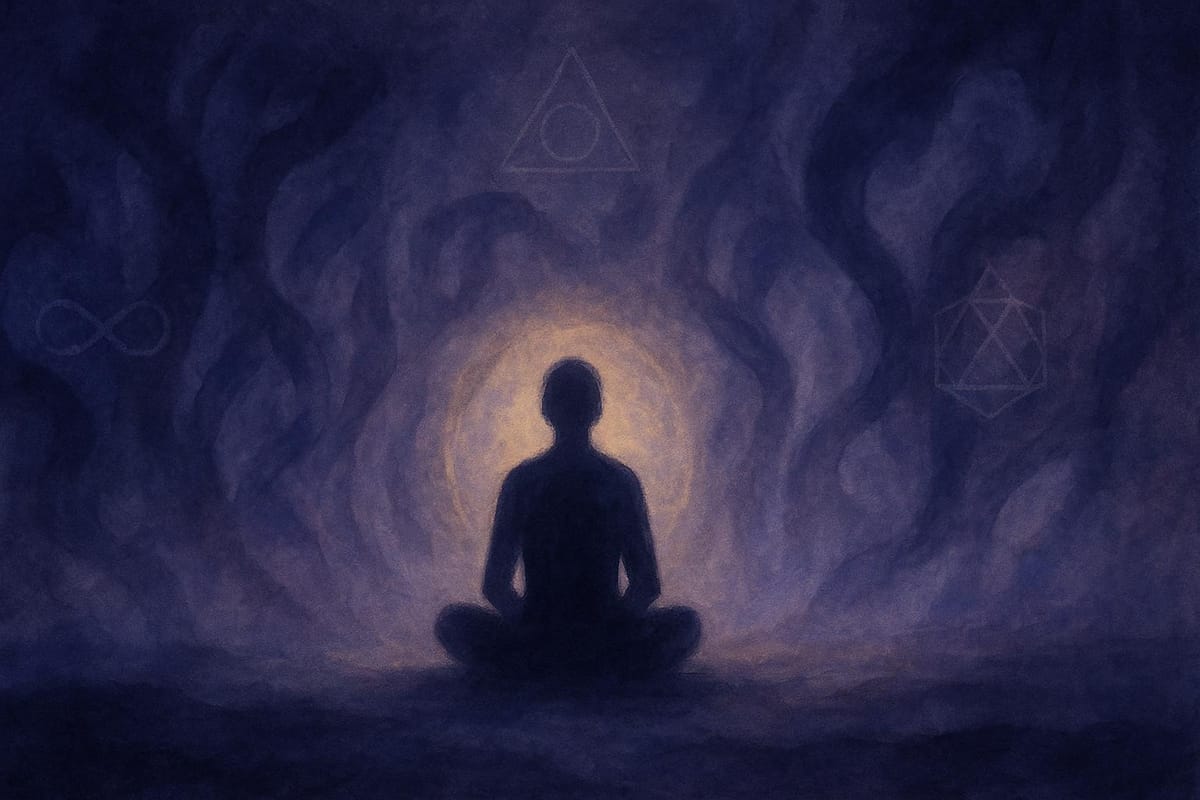Guide to Shadow Integration Through Meditation
Explore shadow integration through meditation to uncover hidden emotions and foster personal growth and self-acceptance.

Shadow integration is the practice of bringing suppressed parts of yourself - your "shadow" - into conscious awareness. These hidden aspects, described by Carl Jung, often include traits or emotions rejected during childhood or deemed unacceptable by society. While ignored, they continue to influence your actions, relationships, and sense of self. Meditation offers a way to engage with these parts gently, helping you observe without judgment, process deep emotions, and integrate them into your life.
Key points:
- What is the shadow? Suppressed traits, emotions, or impulses that shape behavior unconsciously.
- Why shadow work matters: It promotes emotional healing, self-acceptance, and personal growth.
- How meditation helps: It creates a calm space for hidden emotions to surface, strengthens self-awareness, and nurtures compassion.
- Getting started: Prepare a quiet space, set clear intentions, and use grounding techniques like breathwork or body scanning.
Meditation is not about fixing yourself but reconnecting with all parts of who you are. This practice transforms emotional triggers into opportunities for insight, paving the way for deeper understanding and balance.
If this resonates, perhaps it’s time to listen to the signals within and take your first step inward.
Shadow Work Meditation - Reveal Your Hidden Emotions and Core Beliefs
What Is Shadow Integration?
Shadow integration is the practice of acknowledging and accepting the hidden parts of ourselves that we often push away or ignore. These shadow aspects aren't necessarily bad - they're simply the traits, emotions, or impulses that didn’t align with how we wanted to see ourselves or what others deemed acceptable as we grew up.
Think of the shadow as the collection of everything we suppress - unexpressed anger, stifled creativity, or concealed vulnerability. These parts don’t just vanish; they linger in the unconscious, quietly shaping our reactions, relationships, and decisions without us even realizing it.
By working with these hidden aspects, we can experience emotional liberation, authentic self-expression, and a renewed sense of vitality. Instead of battling our inner conflicts, we cultivate a deeper, more honest relationship with who we are.
The roots of this process run deep within psychology. It reveals that our perception of reality is often limited by the narrow self-image we've constructed. As Sacred Illusion suggests, integrating these suppressed parts allows us to step beyond those limitations and take a more active role in shaping our lives. The site emphasizes how this process even enhances manifestation:
"Manifestation isn't magic. It's a co-creative process between your intention, energy, and the structure of reality itself."
The Psychology Behind the Shadow
Carl Jung introduced the concept of the shadow, observing that humans naturally divide their psyche into acceptable and unacceptable parts. As children, we learn which behaviors, emotions, and traits gain approval and which lead to rejection or punishment. The traits that don’t align with societal or familial expectations get buried in the unconscious.
Jung also noted that the shadow isn’t just a repository for undesirable traits - it often hides positive qualities we’ve rejected. For instance, someone raised to value modesty might suppress their natural confidence, or a person taught to always be "nice" might deny their ability to assert themselves. These hidden strengths, often called the "golden shadow", hold untapped potential waiting to be reclaimed.
The shadow often reveals itself through projection. We tend to notice our disowned traits in others, leading to strong emotional reactions. When someone’s actions provoke intense irritation or fascination, it’s often a sign that they’re reflecting something from our own shadow. Our most charged reactions can be powerful clues for uncovering hidden aspects of ourselves, making them invaluable for shadow work.
Understanding these psychological dynamics helps explain why meditation is such an effective tool for shadow integration.
Why Use Meditation for Shadow Work?
Since shadow aspects reside in the unconscious, meditation becomes a powerful way to access them. Meditation provides the perfect environment for shadow material to emerge by creating a calm, neutral space where suppressed emotions and memories can rise to the surface. Unlike purely analytical methods that rely on thinking about the shadow, meditation allows us to directly experience and feel these hidden parts.
In meditation, we bypass the ego’s defenses, which usually keep shadow material out of sight. When we’re relaxed and fully present, suppressed content naturally begins to emerge - whether through vivid images, sensations, emotions, or memories. This process unfolds organically and feels less confrontational than forcing introspection.
Meditation also strengthens the witnessing consciousness, or the ability to observe our inner world without reacting or judging. This skill is essential for shadow work, as it allows us to stay grounded when facing uncomfortable emotions or unsettling realizations. Instead of being overwhelmed, we can simply observe and allow these aspects to exist.
A regular meditation practice also builds emotional resilience and self-compassion, both of which are key to shadow integration. By becoming more comfortable with sitting in difficult emotions during meditation, we develop the inner stability needed to confront and embrace our disowned parts. It teaches us that we can face intense feelings without being consumed by them.
Perhaps most crucially, meditation connects us to a deeper awareness beneath our thoughts and emotions. From this grounded perspective, we can see that our shadow aspects are not fixed truths about who we are - they are simply energy patterns that can be acknowledged, understood, and integrated.
How to Prepare for Shadow Integration Meditation
Diving into shadow work means stepping into parts of yourself that may have been hidden for a long time. Preparing for this journey is like creating a safe container to hold the insights that emerge. The right preparation can make the difference between a meaningful experience and feeling overwhelmed.
Creating a Safe and Sacred Space
Start by choosing a space where you feel secure, private, and free from interruptions. This is your time to focus inward, so let those around you know you’ll need quiet and privacy during your meditation. A calm and undisturbed environment can help you feel grounded as you navigate this inner work.
Setting Intentions with Clarity and Compassion
Before beginning your shadow work, take time to reflect on why you’re embarking on this journey and what you hope to uncover. Vague intentions can leave you feeling unmoored when challenging emotions arise. Instead, craft clear and compassionate intentions to guide you. For example, rather than saying, "I need to fix myself", you might try, "I want to understand and embrace all parts of me with kindness."
Sacred Illusion provides tools like the free Manifestation Intention Generator and Manifestation Goal Planner to help you craft personalized intention statements that resonate with your practice. Writing your intentions down can serve as a powerful anchor during your meditation. As Sacred Illusion beautifully puts it, intention setting is a co-creative process between your energy, your goals, and the structure of reality itself. Approach this step with curiosity rather than judgment, and prepare yourself for the emotions that may surface.
Embracing Self-Compassion and Seeking Support
Shadow work can bring up intense memories and emotions, making self-compassion a vital companion for this journey. Remind yourself that whatever surfaces is part of your growth and does not diminish your worth. Affirmations like "This is hard, and that’s okay" can be comforting in moments of distress.
It’s also important to remember that shadow work doesn’t have to be a solitary process. If you have a history of trauma, depression, or anxiety, consider working with a therapist who specializes in depth psychology or Jungian approaches. As Sacred Illusion wisely reminds us, "The Sacred Path Isn’t Always Pretty". Building a support network - whether through trusted friends, personal growth groups, or online communities - can offer perspective and help you feel less isolated.
Start with shorter meditation sessions and set firm boundaries for your practice, allowing time to process and integrate what you uncover. Resistance and fear are natural parts of this work. Sometimes, the most healing step is acknowledging that you’re not ready to face certain material yet - and giving yourself permission to return to it when the time feels right.
With a supportive space, clear intentions, and compassionate preparation, you can approach shadow integration meditation with confidence and care.
Core Meditation Techniques for Shadow Awareness
With your space prepared and intentions set, it’s time to explore meditation practices that connect your conscious mind with the hidden layers of yourself waiting to be seen and understood.
Grounding Yourself in the Present
Before diving into the deeper recesses of your inner world, it’s essential to establish a stable base - a way to stay anchored when emotions become overwhelming during shadow work. Grounding helps you remain rooted in the present while navigating this introspective journey.
Begin with a simple breath awareness meditation. Sit in a comfortable position and focus on the natural rhythm of your breath. Observe each inhale and exhale without trying to control or change it. If your mind starts to wander, gently guide your attention back to your breathing. This practice provides a steady foundation, allowing you to explore your inner world with a sense of safety.
Another helpful grounding method is body scanning. Slowly direct your attention from the top of your head to the tips of your toes, noticing sensations like tension, warmth, or coolness without trying to alter them. This exercise enhances your connection to physical sensations, which is crucial for shadow work, as repressed emotions often show up in the body.
Spending 5–10 minutes on grounding techniques before deeper exploration can help you maintain emotional balance and stay present as you uncover hidden parts of yourself.
Finding Hidden Parts of Yourself
Once you’ve grounded yourself, it’s time to turn inward and explore the emotions and reactions that point to your shadow aspects. These hidden parts often make themselves known through emotional triggers - those moments when anger, sadness, shame, or fear arise unexpectedly. Such intense emotions can act as doorways to understanding parts of yourself that have been buried or ignored.
During meditation, try emotional tracking. When a strong emotion surfaces, resist the urge to push it away or immediately analyze it. Instead, breathe through it and ask yourself, “What part of me is feeling this?” You might sense a younger version of yourself, a protective inner voice, or a part that feels neglected or misunderstood.
Another approach is trigger reflection. Think about recent situations that provoked strong emotional reactions. Consider whether certain traits in others irritate or anger you - often, the qualities we dislike in others mirror aspects of ourselves we haven’t fully acknowledged. Engage with these insights with curiosity rather than judgment, treating them as opportunities for self-discovery.
Once you’ve identified these hidden emotions or aspects, you can move toward integrating them through visualization techniques.
Using Visualization for Integration
Visualization can be a powerful tool for working with shadow aspects after they’ve been identified. Practices that combine imagery, breathwork, and meditation can help you approach challenging inner experiences with compassion rather than fear.
One method to try is shadow dialogue visualization. Picture yourself sitting across from the shadow aspect you’ve uncovered - it might take the form of a younger version of you, a symbolic figure, or simply a presence. Engage in a gentle conversation. Ask this part of yourself what it needs, what it’s protecting you from, or what message it carries. Listen openly, without judgment, and offer kindness in return.
Another technique is healing light integration. Visualize a warm, golden light enveloping both you and the shadow aspect. Imagine this light dissolving the barriers between your conscious self and the hidden part, creating a sense of unity. The goal isn’t to erase the shadow but to embrace it as part of your whole self. By integrating these hidden aspects, you can transform inner pain into a source of growth and healing.
Common Challenges in Shadow Integration
Shadow work through meditation can open doors to profound personal growth, yet the path is rarely smooth. Understanding common hurdles and equipping yourself with practical tools can make this journey more manageable and meaningful.
Managing Emotional Overwhelm
Delving into the hidden recesses of your being often stirs up intense emotions - grief, anger, shame, and fear can rise to the surface. These waves of emotion are not signs of failure but natural elements of the spiritual awakening process, signaling emotional growth and deeper self-awareness. Alongside these feelings, resistance and fear may also emerge, adding layers of complexity.
During such moments, paced breathing can serve as your anchor. Try this: inhale for a count of four, hold your breath for another four, and then exhale slowly for six. This simple practice engages your parasympathetic nervous system, creating a sense of safety as you navigate intense emotions.
Another grounding technique involves connecting with physical sensations. Place one hand on your chest and the other on your belly, and tune into the rhythm of your breath or the feel of your body against a surface. This practice can help you stay present and grounded during emotional surges.
Rather than viewing emotional overwhelm as something to fix, consider it an indicator that you’re uncovering something meaningful. These emotions are like messengers, offering valuable insights into your inner world.
Working Through Resistance and Fear
When meditating on shadow aspects, it’s common for your mind to push back. Resistance might show up as procrastination, sudden fatigue during meditation, or physical tension when certain emotions surface. This isn’t a failure on your part - it’s your psyche’s way of clinging to the familiar. Fear often walks hand in hand with resistance, as confronting hidden aspects of yourself can feel unsettling.
When resistance or fear arises, gently ask yourself, “What is this trying to protect me from?” This question can reveal underlying wounds or beliefs shaped by past experiences.
If the idea of diving into your deepest shadows feels daunting, start small. Begin with minor irritations or mild emotional triggers rather than tackling the most intense aspects right away. These smaller steps can gradually build your capacity for deeper exploration.
"The Sacred Path Isn't Always Pretty explores the transformative power of shadow work and grief on the path of spiritual awakening, embracing both light and darkness for deeper understanding." – Sacred Illusion
Acknowledging your shadow isn’t about admitting flaws - it’s about reclaiming the parts of yourself you’ve hidden or rejected. These aspects are integral to your humanity, and integrating them can lead to greater authenticity and compassion.
Maintaining a Consistent Practice
Consistency is key to making shadow integration a sustainable part of your life. However, maintaining regularity can feel challenging, especially when resistance or emotional intensity disrupts your rhythm. Even after moments of breakthrough, it’s common to encounter stop-and-start patterns in your practice.
To stay on track, track your emotional patterns. Notice when you’re most likely to avoid meditation and identify the feelings or circumstances that trigger resistance. This awareness can help you navigate obstacles more effectively.
Seek connection with others who are walking a similar path. Shadow work can feel isolating, but sharing experiences with someone who understands can provide much-needed support.
Finally, stay flexible. On days when formal meditation feels overwhelming, you can still engage with shadow work in smaller ways. Pay attention to your inner dialogue or acknowledge difficult emotions as they arise during your daily activities. These informal practices can keep you connected to the work, even when deeper exploration feels out of reach.
Shadow integration is a journey of ups and downs, breakthroughs and setbacks. Embracing this natural rhythm can help you stay committed, as every challenge holds the potential for new understanding and healing. Each step forward, no matter how small, contributes to the unfolding of your wholeness.
Integration, Transformation, and the Illusion of Self
When you face your inner struggles and embrace the parts of yourself you’ve hidden, a profound transformation begins. Through meditation and shadow work, you weave these once-rejected pieces back into the whole, mending old wounds and reshaping your path forward.
Personal Growth Through Shadow Work
The process of integrating your shadow influences every aspect of your life. Relationships become more honest and grounded as you stop projecting your unclaimed traits onto others. Instead of reacting impulsively, you take ownership of your emotions, creating space for deeper, more meaningful connections.
Qualities you once rejected reveal themselves as sources of insight and strength. By welcoming both your light and shadow, you break free from restrictive stories about who you are. This opens the door to a version of yourself that feels more expansive and aligned with your true nature.
As you reclaim these hidden aspects, your energy aligns with your core intentions, creating a sense of balance and inner harmony. In this process, the rigid identity you once clung to starts to dissolve, making way for a more fluid and authentic sense of self.
Seeing Through the Illusion of Self
Through consistent meditation, you begin to recognize that the identity you’ve been protecting is, in many ways, a construct shaped by your shadow. Shadow work uncovers how much of your personality, values, and even your spiritual journey have been built in response to the parts of yourself you once rejected. As these pieces are reclaimed, the rigid framework of who you thought you were starts to fall away.
This unraveling isn’t a loss - it’s a liberation. Letting go of old identities allows you to step into a life that feels aligned with your deepest truths. Instead of moving through life on autopilot, you awaken to a more intentional and self-guided existence.
"Why do some people feel like they're asleep inside the simulation - and others seem to shape it from the inside? This post explores NPCs, Players, and what it really means to wake up and take control of your role." - Sacred Illusion
As you reflect on this, you begin to see reality itself as more flexible than you once believed. Shedding the constraints of a narrowly defined identity opens the door to co-creation, where your emotions, intentions, and integrated energies actively shape your world. Your journey becomes a conscious dance with existence, turning personal healing into a dynamic engagement with the mystery of life itself.
Conclusion: Using Shadow Work as a Path to Wholeness
Shadow integration through meditation isn’t a finish line - it’s a lifelong unfolding, reshaping the way you connect with yourself and the world around you. Each session of meditation becomes a step deeper into transformation.
The grounding and visualization techniques you develop become enduring companions on this path of self-discovery. Over time, the line between your internal landscape and external reality begins to fade. Repressed emotions surface, not as obstacles, but as messengers carrying hidden wisdom. These moments spark profound questions about the true nature of the self.
"The Sacred Path Isn't Always Pretty: Explore the transformative power of shadow work and grief on the path of spiritual awakening, embracing both light and darkness for deeper understanding." - Sacred Illusion
This idea serves as a bridge, linking your personal inner work to the greater awakening that ripples through the collective.
What gives shadow work its profound impact is its ability to dismantle the illusion of separateness. The more you stop projecting unconscious patterns onto others, the clearer it becomes how life’s challenges act as mirrors. These reflections not only guide your personal evolution but also contribute to a shared healing.
This path requires courage and dedication. When overwhelming emotions or resistance arise, they are not barriers but invitations to go further. Each moment you choose presence over avoidance, you’re choosing wholeness over fragmentation, truth over illusion.
As you continue integrating your shadow through meditation, remember you are part of a larger unfolding. Across the world, others are questioning, exploring, and seeking meaning - whether they see life as code, myth, or something else entirely. Shadow work equips you to move through this mystery with awareness and sincerity.
Ultimately, the journey to wholeness isn’t about striving for perfection; it’s about embracing completeness. By honoring every part of your humanity - and the divine spark within - you heal the past, shape the future, and take your place as an active co-creator of reality.
FAQs
How do I know if I'm ready to start shadow integration meditation?
If you're feeling drawn to explore the depths of your inner world and are open to sitting with emotions that might feel uneasy, you may be ready to begin shadow integration meditation. This practice calls for a sense of self-awareness and a sincere desire to uncover the parts of yourself that often remain hidden.
Take a moment to consider if you're willing to engage in honest self-reflection and embrace the path of personal growth. Approaching this process with patience and kindness toward yourself is key - if that resonates with you, it could be the right time to begin.
How can I tell if my shadow is affecting my thoughts or actions?
When your shadow exerts its influence, it often whispers through the cracks of your daily life, manifesting in ways that are easy to overlook but hard to escape. You might feel waves of anger, fear, or sadness that seem disproportionate to the moment, as if they belong to a deeper well within you. Habits that undermine your progress - like procrastination or turning to unhealthy escapes - may also be signs of its presence. In relationships or life events, you might notice recurring patterns, such as repeated conflicts or the sensation of being trapped in the same scenarios. These moments aren’t random; they are signals from the unseen parts of yourself, quietly asking to be seen and brought into harmony.
How can I manage strong emotions that come up during shadow work meditation?
It’s common for deep emotions to rise during shadow work meditation, as this practice uncovers parts of yourself that often remain hidden. When these feelings emerge, meet them with kindness and curiosity. Understand that such emotions are not obstacles - they’re signals of growth and healing.
To manage overwhelming sensations, anchor yourself in your breath to remain steady and present. If the intensity feels too much, pause. Write down your thoughts, reflect, or reach out to a trusted guide or therapist for support. Above all, approach this journey with self-compassion, allowing space for the integration of these profound layers within you.




